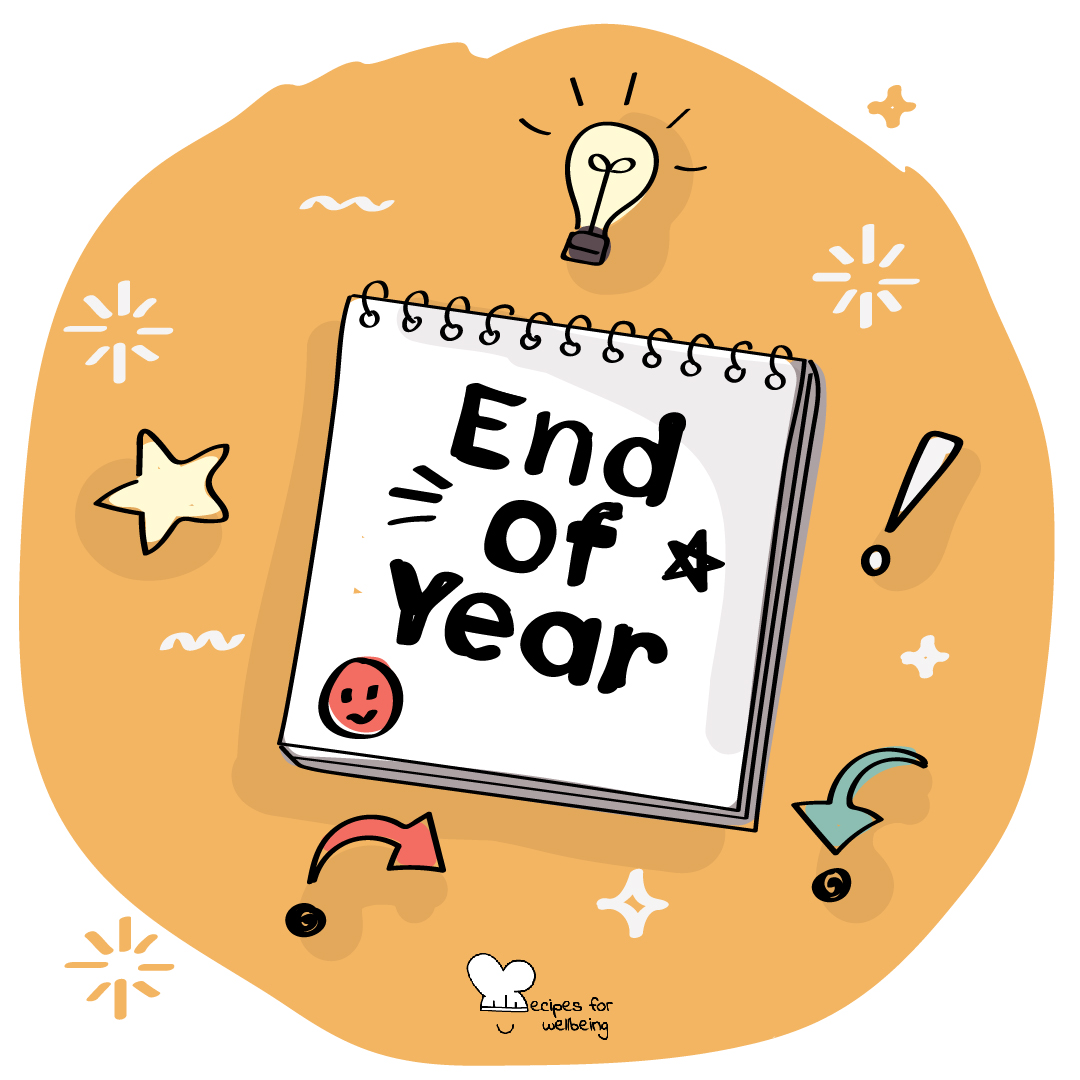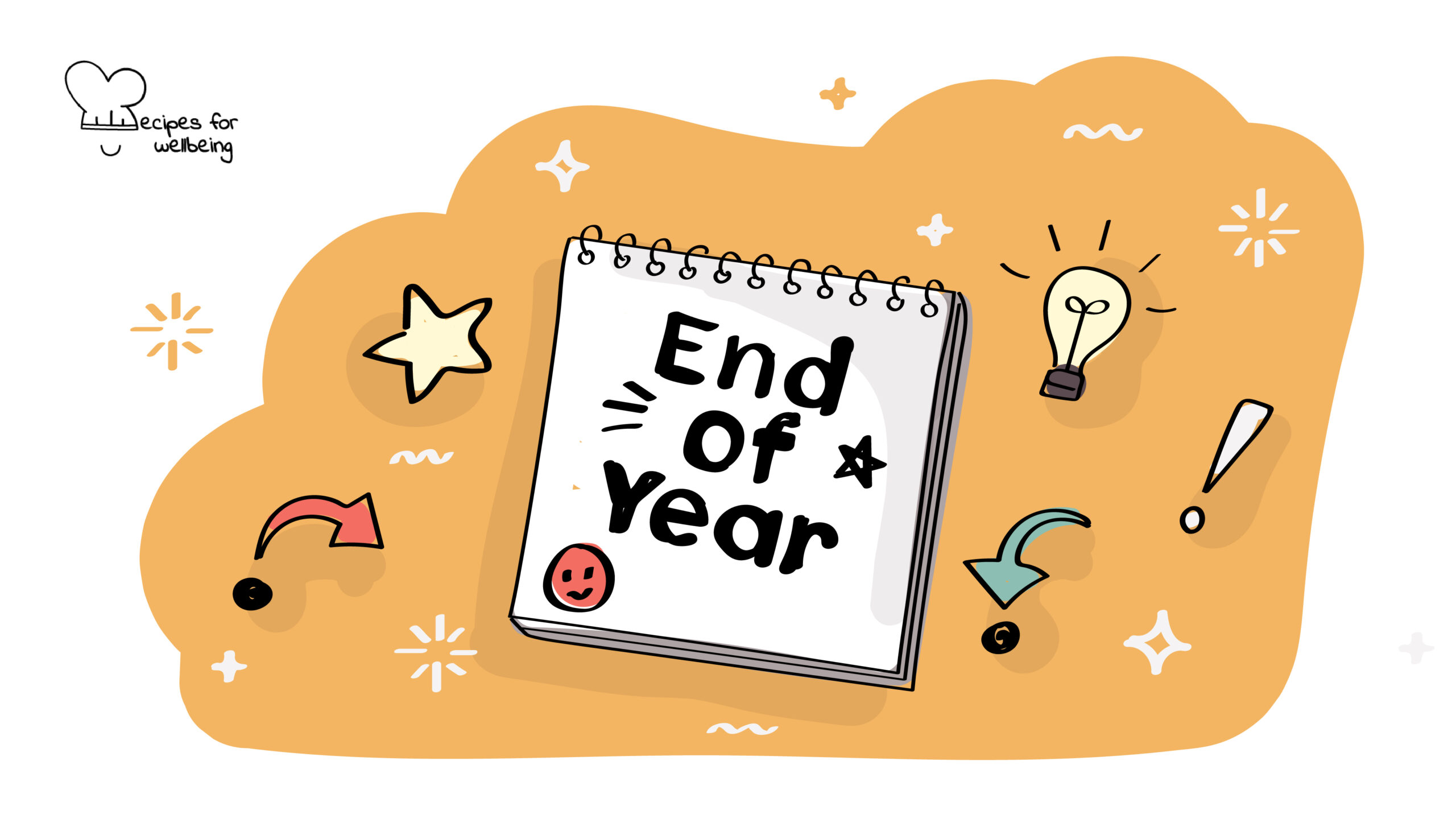
End-of-year reflection
For last year’s words belong to last year’s language and next year’s words await another voice. And to make an end is to make a beginning. ―T. S. Eliot
 Serves: 11-25 people, 2-10 people
Serves: 11-25 people, 2-10 people
 Difficulty: Easy
Difficulty: Easy
 Total time: 61-120 minutes
Total time: 61-120 minutes
 Ingredients: Template provided or A4 sheet of paper (1 per participant), coloured pens and markers
Ingredients: Template provided or A4 sheet of paper (1 per participant), coloured pens and markers
 Wholebeing Domains: Accomplishments, Awareness, Positive Emotion, Ritualising
Wholebeing Domains: Accomplishments, Awareness, Positive Emotion, Ritualising
 Wholebeing Skills: Aligning with the cycles, Celebration, Contentment, Goal-setting, Gratitude, Intention-setting, Legacy, Planning, Reflection, Ritualising
Wholebeing Skills: Aligning with the cycles, Celebration, Contentment, Goal-setting, Gratitude, Intention-setting, Legacy, Planning, Reflection, Ritualising

End-of-year reflection
 Description
Description
A reflective practice to bring closure to your year and open the new one.
For many people, the end-of-year period is often marked by a mixture of working way too much as they attempt to wrap up the unwrappable; eating and drinking a little bit too much as they attend yet another end-of-year office, community, gym party; increasing anxiety for the zero gifts purchased so far, and worrying that time flies as another year comes to a close.
Our Year Compass recipe is perfect if you want to give yourself half a day or so for some deep reflection on your past year and thorough planning for the new year. But if you can’t spare that time, we have crafted a shorter creative and still reflective activity for you. This recipe, end-of-year reflection, has been adapted from an online huddle we attended that was beautifully led by the Unity Effect and it can be done with a friend (or group of friends), with your family, or even work colleagues.
•••
This recipe has been featured in our blog post “Time to wrap up 2020 (finally!)” published on tbd* on 15 December 2020.
 Steps
Steps
Step 1 – Prior preparation (10’)
Set up the space nicely so that it feels calm, cozy, and welcoming. You may want to light a candle, put some relaxing music, or prepare a fruity infusion. Also, have the material ready on the table: a printed template for each of your participants (or a blank A4 sheet of paper) and various coloured pens and markers.
Step 2 – Check-in (10’)
Once your participants arrive, welcome them and lead a quick check-in, perhaps asking them how they are at that moment, or what expectations they might have for this activity.
Step 3 – Reflect (10’)
Hand out a template (or sheet of paper) to each participant and tell them they have 10 minutes in silence to write and/or draw the successes and accomplishments from their past year, both personal and professional. Explain that an accomplishment could also be overcoming a negative experience. Invite them to be creative and use different colours.
Step 4 – Highlight (10’)
Once the five minutes are up, give them a gentle nudge (you may want to use a gong/cymbals sound – easy to find online if you don’t have a pair of cymbals or Tibetan singing bowl). Now explain that you will give them three different prompts, one every two minutes.
- First round: Look at what you wrote/drew and highlight the accomplishments you are most proud of drawing a star next to them like shown here.
- Second round: Look again at your paper and highlight the situations that challenged you the most by drawing an exclamation mark next to them like shown here.
- Third round: Look once again at your paper and highlight the events where you learned the most by drawing a lightbulb next to them like shown here.
Step 5 – Sharing and deep listening (20’)
Now invite participants to pair up with someone else (if they are an odd number you can join in as well so everyone has a partner) and explain they will now get to share and practise deep listening. This is how it works: Partner A has 4 minutes to share as little or as much as they want from their reflection whilst Partner B is present and listens actively. If there is silence, let there be silence, partner B is not to interfere. At the end of the 4 minutes, Partner B has 2 minutes to reflect back what they heard, noticed, and observed. Then Partner A has another 2 minutes to add further insights after hearing Partner’s B reflection. At the end of the 8 minutes, partners swap roles and repeat the process. Mention that participants can find somewhere more private where they can share, as long as they can hear the sound you will play to notify them about the timing.
Step 6 – Quick circle sharing (10’)
Regather your participants and take 10 minutes to open a quick sharing circle for anyone who might want to say a couple of words on the pair sharing.
Step 7 – Leave behind and welcome in (5’)
Bring the sharing circle to a close as a way to also help your participants move from this year onto the new year. Explain that you will give them another couple of prompts to reflect on for two minutes:
- First round: What would you like to leave behind from this year? Draw an arrow moving outward like shown here.
- Second round: What would you like to take forward into next year? Draw an arrow moving inward like shown here.
Step 8 – End with a toast (15’)
As a way to close the activity and bring in a little bit of celebration, invite each participant to end with a toast to the year that is just coming to an end. Once everyone has shared a toast, you might actually want to toast for real (with your fruity infusion, of course!).


 Arabic
Arabic Chinese (Simplified)
Chinese (Simplified) Dutch
Dutch English
English French
French German
German Italian
Italian Portuguese
Portuguese Russian
Russian Spanish
Spanish